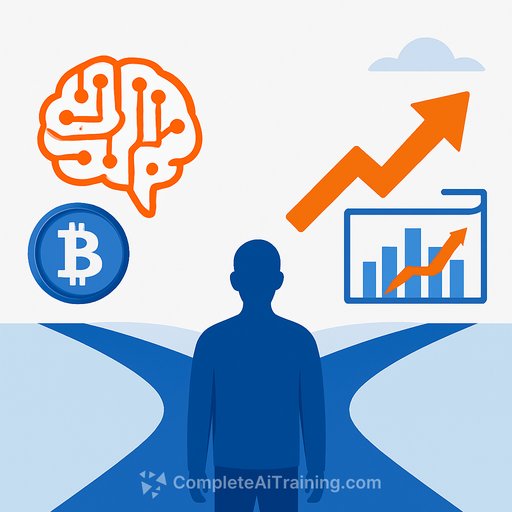AI, crypto, and the economy: What finance pros should do heading into 2026
Markets are pressing new highs while macro risks keep stacking up. AI spend is lifting profits and multiples, yet parts of the economy feel stuck. Crypto is maturing, regulation is loosening, and retail capital keeps showing up. Here's the signal from this week's conversations - distilled for portfolio, treasury, and strategy decisions.
Macro: A more dovish Fed, a two-track economy
Anne Walsh expects a rate cut in December and further cuts in 2026, with a more dovish-leaning Fed on deck. A new chair - from a short list that includes Kevin Warsh, Kevin Hassett, Chris Waller, Michelle Bowman, and Rick Rieder - could tilt policy toward a lower neutral rate.
Lael Brainard emphasized the importance of Fed independence as Chair Powell's core legacy, a pillar for price stability and credibility. She sees a "two-track" economy: AI investment is strong but not labor hungry, while the rest of the economy is digesting tariffs and constrained by tighter capital.
What it means: modest duration extension makes sense into a cutting cycle; interest-sensitive pockets should breathe; watch credit selection as growth looks uneven. For policy backdrop context, see the Federal Reserve's overview on institutional independence. Read more.
AI and talent: Productivity first, new work second
Robert F. Smith expects a major productivity step-up. Data synthesis gets automated; value shifts to "whole brain" skills - creativity, context, and systems thinking that turn AI output into business outcomes.
Alexis Ohanian expects more jobs created than lost and urges schools to integrate AI for personalized learning. Max Levchin is optimistic about better work, with a clear caveat: invest in security and safeguards to prevent misuse.
Practical moves for finance teams: pilot AI agents for reporting, variance analysis, and pipeline triage; train teams to ask better questions and validate AI output; tie AI projects to measurable P&L or working-capital wins. If you're building capability, here's a vetted catalog of AI tools for finance. Explore tools
Crypto: Convergence with TradFi, patient positioning
Vlad Tenev sees crypto and financial services "fully merge" over time - stablecoin-powered banking, tokenized exposure to US and global assets, and blurred lines between prediction markets and investing. He also flagged a durable shift: public companies will need to engage retail investors with richer, direct communication.
Arjun Sethi isn't rushing Kraken to the IPO window, preferring discipline over trend following. Eric Trump expects dollar-pegged stablecoins to pull large pools of capital into the US, arguing supportive policy will accelerate onshoring.
The biggest risk for crypto allocators right now, per John D'Agostino: trying to time entries. Dollar-cost averaging, tight custody playbooks, and clear liquidity tiers remain the professional move while regulatory "unlocks" progress. Mark Palmer's reminder: this asset class is still early - size bets accordingly.
Equities: AI premium, not a bubble (yet)
Keith Lerner's read: valuations are rich, but not dot-com-bubble territory. Tech trades near 30x vs. ~50x then, and profits have kept pace with prices. Expect pullbacks and rotations without breaking the longer trend in AI-driven earnings.
Sectors and operators to watch
- Airlines: Delta's premium pivot crosses a key threshold - premium seats set to exceed main cabin sales. Expect heavier cabin-mix focus, higher onboard monetization, and deeper media partnerships to capture a captive, high-intent audience.
- Pharma/Obesity: Pfizer doubled down to win Metsera and its monthly GLP-1, targeting launches around 2028. Scale in trials and manufacturing will matter as capacity and pricing set the curve for the category.
- Payments/Fintech: Robinhood is stitching banking, crypto, and prediction markets into one ecosystem and even offering discreet cash delivery - a reminder that cash friction still exists, even as digital share grows.
- Activism/Restaurants: Jeff Smith wouldn't rule out re-engaging at Papa John's as the company explores strategic alternatives. Volatile sponsor interest should keep special-situations investors active.
- SMB hiring: Daymond John hears companies holding prices but trimming staff to protect demand - with trades gaining. For employers, spend where it drives conversion and automate the rest.
Policy frame: Four pillars driving 2026
Trade/tariffs continue to influence costs and capital allocation. Deregulation is quieter but ongoing. Tax changes bring fresh clarity and potential tailwinds. Immigration (or "reverse immigration") will affect labor supply and wage pressure. Portfolio and hiring plans should reflect all four.
What to watch next
- December cut odds, 2026 path, and the next Fed chair selection.
- AI capex impact on margins beyond megacaps; breadth improvement vs. concentration risk.
- Stablecoin policy, tokenization pilots, and onshore vs. offshore liquidity shifts.
- GLP-1 capacity scaling, payer coverage, and second-generation molecules.
- Airline premium mix, unit revenue, and advertising/partnership monetization.
Moves for finance leaders this quarter
- Rebalance duration ahead of a likely easing cycle; stress test credit for uneven growth.
- Barbell equities: AI infrastructure and software with cash-flow compounders in value/cyclicals.
- If mandate allows, formalize a DCA policy for core crypto exposure; define custody, liquidity, and drawdown rules.
- Upgrade investor relations for retail participation: livestreams, Q&A, and clear KPI storytelling.
- Stand up 1-2 AI automations tied to cash or margin (invoice matching, forecast variance notes, FP&A close tasks); measure hard savings.
Final thought: AI is delivering profits, but it's not hiring for the whole economy. That gap is your opportunity - in allocation, process design, and skills. Build the muscle now, so you're not forced to react later.
Your membership also unlocks:






